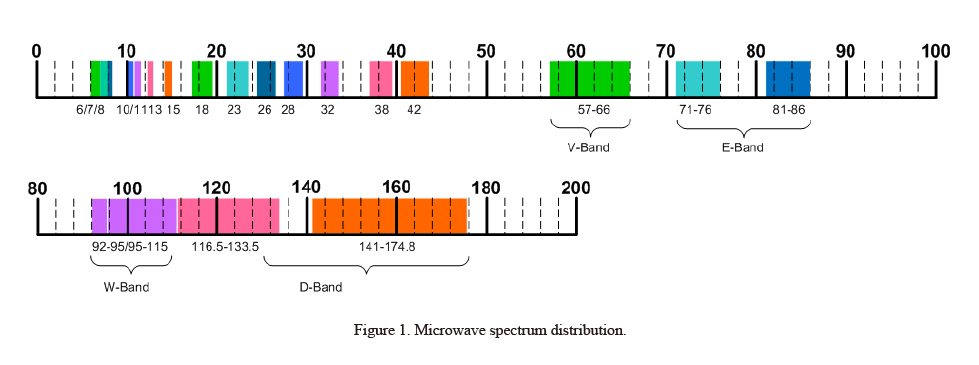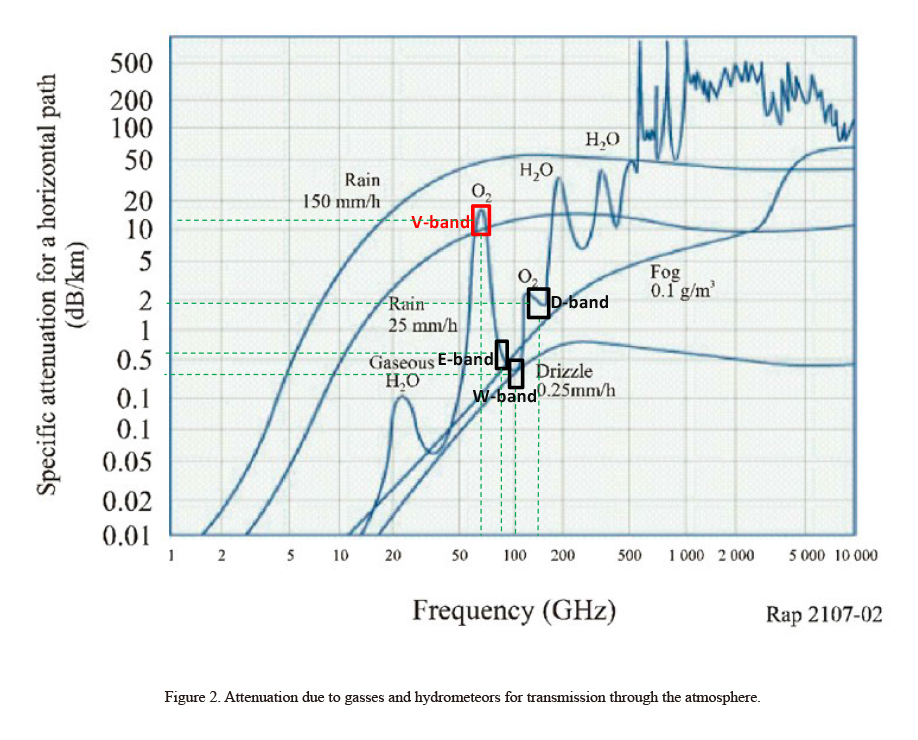An Analysis of High-Frequency Microwave Technologies
Microwave Spectrum Status
Traditional microwave spectrum is nearing exhaustion. To meet the large transmission capacity of future networks, the industry has proposed many new solutions that use higher frequency bands, higher modulation, MIMO, co-frequency co-time full duplex (CCFD), faster than Nyquist (FTN), and orbital angular momentum (OAM). This article focuses on technologies and applications of high frequencies (60 GHz and above).
ITU has regulated the microwave spectrum below 134 GHz. The spectrum below 42 GHz is referred to as the traditional bands. The 57–66 GHz band is referred to as V-band. The 71–76 and 81–86 GHz bands are referred to as E-band. However, there is not an industry-wide definition of W-band and D-band. Currently, W-band refers to the spectrum around 100 GHz and D-band refers to the frequency range from 130 to 175 GHz. Figure 1 shows how the spectrum is divided.

Features of High-Frequency Microwaves
High-frequency bands (>60 GHz) have a more extensive spectrum and wider bandwidth. Such frequency bands have the following features:
● Narrow beam: In a point-to-point microwave transmission system, antennas operating at higher frequencies emit a narrower beam and more concentrated energy. For example, an E-band parabolic antenna with a gain greater than 50 dBi has half-power beamwidth of less than one degree. This means lower risk of interference in space transmission and more flexibility in frequency planning. High-frequency microwave equipment is more suitable for large-scale deployment in densely-populated urban areas. However, it is inconvenient to adjust these devices. During engineering commissioning, some measures need to be taken to facilitate microwave link provisioning.
● Short transmission distance: With very short wavelengths, high-frequency microwaves are highly influenced by free space loss and rain attenuation, and the transmission distance is short in most cases. V-band has high oxygen absorption and the shortest transmission distance (Fig. 2). However, attenuation is less pronounced at E-band, W-band, and D-band, which deliver transmission distances of around 1 km and availability of up to 99.999%. In some particularly arid areas or over links without high availability requirements, the transmission distances can be extended to 3 km or even longer.

● Low latency: In a 4G network, the main application scenario for microwave is still backhaul that provides millisecond-level latency. 5G will require bigger capacity and lower latency. The 5G midhaul and backhaul require latency ranging from 100 us to several ms, while the 5G fronthaul requires latency of less than 50 us. Conventional microwave equipment is difficult to meet the much stricter capacity and latency requirement for fronthaul. High-frequency microwave equipment offers larger capacity, greater bandwidth, and thus greatly reduces latency in transmission. Take an E-band device as an example. When using 2 GHz bandwidth and 128 QAM, it can deliver 10 Gbps throughput per link with less than 20 us latency. This meets the low-latency requirements of 5G fronthaul.
● Low TCO: Due to the large capacity supported by high frequencies, the average transmission cost per bit is gradually reduced. Usage fees for high-frequency resources vary from country to country, but they are still much lower than those for the traditional frequency bands. V-band is an unlicensed band for general public use. E-band is lightly licensed, which requires low spectrum fees. W-band and D-band have not yet been used. However, it is worth noting that, in recent years, with the increased adoption of E-band, usage fees for it are on the rise. Some countries have increased usage fees for E-band to the same level as those for the traditional frequency bands.
High-Frequency Microwave Applications
E-band (71–76 GHz and 81–86 GHz) used for FDD mode is a pair of 5 GHz channels. It offers bandwidth of 62.5 MHz to 2 GHz and delivers up to 10 Gbps throughput at 128 QAM. In a 4G network, E-band can be used alone for short-distance large-capacity backhaul and CPRI fronthaul, or used together with the traditional bands to support large-capacity, long-distance and multi-band backhaul. With the move to 5G, fronthaul and midhaul applications will gradually increase. Fronthaul connections will need to scale up to 30 Gbps with the latency requirements lower than 30 us. E-band featuring large capacity and low latency is preferred for such a scenario. The 5G midhaul and backhaul will still mainly use the multiband approach to provide 10 Gbps to 25 Gbps capacity while meeting the latency requirements of 100 us.
V-band (57–66 GHz) offers bandwidth of 50 MHz to 2 GHz. V-band can be used for both FDD and TDD modes. This band is greatly affected by oxygen absorption, so the transmission distance is usually within 300–800 meters. This makes V-band the suitable solution for street-level connectivity. When a V-band product operates in FDD mode, the point-to-point solutions are deployed in most cases to provide data transmission for enterprises and small cells. When a V-band product operates in TDD mode, uplink and downlink transmissions occur simultaneously and PtMP solutions are often deployed. V-band is open for unlicensed operation in many countries and is used primarily by enterprise users in actual deployments.
W-band (92–115 GHz) and D-band (130–175 GHz) are not clearly defined by standard bodies. However, higher microwave frequencies will be used in the future to handle the growth of wireless data traffic and the increasing capacity demands of 5G. The atmospheric absorption in W-band and D-band does not increase sharply with increasing frequency (Fig. 2), which is similar to that in E-band. The gain of high-frequency antennas is big. Therefore, these two bands can be used to enable high capacity connectivity. Some companies and organizations are now able to provide relevant product demos.
Conclusion
With the increasing demands for large capacity and low latency in future networks, high-frequency microwave technologies will be more widely used in microwave systems.